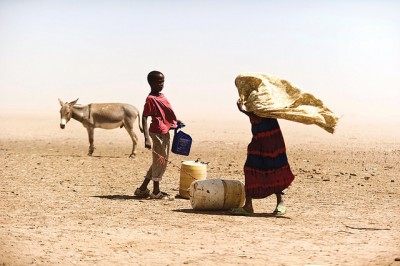 Bread for the World / Flickr
Bread for the World / Flickr
The Growing Issue of Climate Migration
Climate change is usually presented as an environmental issue, but its consequences also present legitimate threats to global security. The societies we have built are founded on stable environmental conditions, and climate change is already weakening this foundation enough to cause major repercussions. As that foundation crumbles, people will move to places of less danger and with more opportunity putting an increasing numbers of migrants and displacees on the road. Migration is serious secondary effect of climate change. The United Nations (UN) and the International Organization for Migration (IOM) estimate between 50 million and 200 million people could be displaced by 2050 because of climate change’s effects. The IOM also estimates the likelihood of being displaced by a natural disaster is 60 percent higher today than 40 years ago.
One of the biggest challenges in addressing climate-induced migration is that legally the term ‘climate refugee’ does not exist. Even though the phrase is frequently used, climate and environmental issues do not fall within the definition of a refugee established in the 1951 Refugee Convention (the United Nations Conference of Plenipotentiaries on the Status of Refugees and Stateless Persons). This is important because people who have been legally declared a refugee are given protection in the international system such as having safety from being returned to the dangers they have fled; access to fair and efficient asylum procedures; and measures to ensure that their basic human rights are respected to allow them to live in dignity and safety while helping them to find a longer-term solution.
Instead of using the term ‘climate refugees’, it is more accurate and effective to use the terms ‘climate migrants’ and ‘climate displacees’. Climate migrants are people who voluntarily choose to leave their homes to improve their lives due to environmental concerns. They are typically challenged by gradual deterioration of environmental conditions including phenomena such as desertification, reduction of soil fertility, coastal erosion, and sea-level rise. Climate displacees are people who are forced to leave their homes because their lives and welfare are placed at serious risk due to adverse environmental effects. They are usually struck by sudden-onset natural disasters such as hurricanes, tsunamis, floods, and the like – they have no choice but to flee. Of course, this is not simply a black or white categorization, but shades of gray. Climate migration is best understood as a continuum, ranging from clear cases of forced to clear cases of voluntary movement.
Current discussions of climate-induced migration focus on forced displacement, with an emphasis on the destruction of people’s homes. This is an issue and prevents us from seeing the real problem, because although natural disasters are more likely to result in sudden mass displacement, a larger number of people overall are expected to migrate due to gradual deterioration of environmental conditions. Climate migrants will outnumber climate displacees.
One of the reasons the discussion emphasizes climate displacees is because oftentimes climate migrants can be perceived as economic migrants, those who move primarily for economic reasons. This is especially true since most climate migration trends toward domestic urbanization. Often, what compels people to move is “not so much the pull of economic opportunity as the push of a changing climate.” (The Guardian). Thus, it is critical to research not only the numbers and locations of migrants, but also their personal stories and reasons for departure.
Migration exacerbates existing instability, and can lead to conflict. For example, the climate change induced droughts of 2006-2011 contributed to mass internal displacement within Syria. Since the drought lead to increased poverty and relocation to urban areas, “That internal displacement may have contributed to the social unrest that precipitated the civil war.” (TIME). Other regions, such as the Sahel, are also experiencing a surge in climate migrants due to droughts and floods, for example in 2013 it was estimated that about 30% of households in part of Burkina Faso’s Sahel zone have moved away in the past 20 years because they could no longer survive on the infertile land. Small island states are also especially vulnerable to climate change due to their small size, low elevation, remote geographical location, and concentration of infrastructure along coastlines. Climate migrants and displacees from these areas could have a significant impact on the security of countries that take them in. For example, under a 1986 compact, the roughly 70,000 residents of the Marshall Islands, because of their long military ties to Washington, are free to immigrate to the United States.
But this is not just a foreign issue, the number of American climate migrants and displacees is expected to rise. Recently, the Isle de Jean Charles in Louisiana received the first allocation of federal tax dollars to move an entire community struggling with the impacts of climate change. In January, the Department of Housing and Urban Development announced grants totaling $1 billion in 13 states to help communities adapt to climate change, by building stronger levees, dams and drainage systems. But in some cases, money will not be able to move fast enough to save communities. The Yupik community in Newtok, Alaska is predicted to be completely underwater by 2017.
Globally, protection for climate migrants and displacees remains inadequate, leaving millions of people vulnerable to the harsh conditions of an ever-changing climate. There is a need for a strong inter-governmental system of protection. If left without protection, millions of migrants and displacees will put a strain on governments worldwide, and contribute to instability. Additionally, countries need to continue working to stop climate change, as like all problems, climate migration is easier to prevent than correct.





